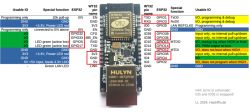Hi, I have a twisted pair cable drawn to each of the boxes in my house and would like to use it to control lighting and roller shutters. While the subject of roller shutters seems fairly straightforward to me, I can't (maybe I've searched poorly) find lighting control modules (1, 2 and 3 channel). I'd like to keep the current candlestick switches, but add the ability to switch the lights on over the twisted pair. I don't know if I'm approaching the subject correctly because, to my surprise, finding such wired controlled modules is probably impossible. Ultimately the whole thing is to be operated by a Raspberry Pi and an app on a phone. Are there any off-the-shelf modules available that will allow switching both from buttons and remotely?





